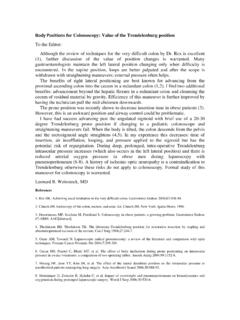Transcription of Naltrexone as Therapy for Inflammatory Bowel …
1 Naltrexone as Therapy for Inflammatory Bowel Disease: Ulcerative Colitis and Crohn s Disease Leonard B. Weinstock, MD, FACG Specialists in Gastroenterology, LLC, St. Louis, MO A relatively unknown approach to Inflammatory Bowel disease is the use of low dose Naltrexone . Reports of Naltrexone for Crohn s disease first started in 2007 from Pennsylvania State University. As with any Crohn s disease Therapy it is rare to get more than 70% efficacy from any medicine since there are many pathways for inflammation. The same is true for ulcerative colitis treatment.
2 An article ( below ) that was published in 2014 in the Journal of Clinical Gastroenterology provides detailed information how Naltrexone works in Inflammatory Bowel disease and what was found in my practice in both ulcerative colitis and Crohn s disease. The experience of the Penn State group is summarized as well. Cautionary warnings 1. Because LDN blocks opioid receptors throughout the body for three or four hours, people using medicine that is an opioid agonist, narcotic medication such as Ultram (tramadol), morphine, Percocet, Duragesic patch or codeine-containing medication should not take LDN until such medicine is completely out of one's system.
3 Patients who have become dependent on daily use of narcotic-containing pain medication may require 10 days to 2 weeks of slowly weaning off of such drugs entirely (while first substituting full doses of non-narcotic pain medications) before being able to begin LDN safely. 2. LDN should not be taken during pregnancy until research into that question is completed. 3. Those patients who are taking thyroid hormone replacement for a diagnosis of Hashimoto s thyroiditis with hypothyroidism ought to begin LDN at the lowest range ( for an adult).
4 Be aware that LDN may lead to a prompt decrease in the autoimmune disorder, which then may require a rapid reduction in the dose of thyroid hormone replacement in order to avoid symptoms of hyperthyroidism. 4. Full-dose Naltrexone (50mg) carries a cautionary warning against its use in those with liver disease. This warning was placed because of adverse liver effects that were found in experiments involving 300mg daily. The 50mg dose does not apparently produce impairment of liver function nor, of course, do the much smaller 3mg and doses.
5 5. People who have received organ transplants and who therefore are taking immunosuppressive medication on a permanent basis are cautioned against the use of LDN because it may act to counter the effect of those medications. FDA approval status Naltrexone itself is an FDA-approved drug, but the varied uses of LDN still await application to the FDA. The FDA approved Naltrexone at the 50mg dosage in 1984. LDN (in the 3mg or dosage) has not yet been submitted for approval because the prospective clinical trials that are required for FDA approval need to be funded at the cost of many millions of dollars.
6 Physicians understand that appropriate off-label use of an already FDA-approved medication such as Naltrexone is ethical and legal. Because Naltrexone itself has already passed animal toxicity studies, one could expect that once testing is able to begin, LDN could complete additional clinical trials in humans and receive FDA approval for one or more uses within two to four years. More information about Naltrexone : Article: Naltrexone as Therapy for Inflammatory Bowel Disease: Ulcerative Colitis and Crohn s Disease Leonard B. Weinstock, MD, FACG BACKGROUND & AIMS: Low dose Naltrexone reduces Crohn s disease activity and mucosal inflammation.
7 Naltrexone treatment of ulcerative colitis has not been reported. METHODS: This open-label retrospective study reports on adults with moderate to severe ulcerative colitis failing 5-aminosalicylates with mercaptopurine and/or infliximab. Naltrexone was added as adjunctive Therapy . Adverse events were queried. Preliminary evidence for clinical efficacy was determined by self-assessed questionnaires. Positive responses included markedly or moderately improved . Failed responses were mild or temporary help , not helped or withdrew due to side effects.
8 RESULTS: Twelve patients received Naltrexone mg/day. Duration (mean SD) of Naltrexone treatment was 46 75 weeks (maximum 270 weeks). One patient withdrew after 8 weeks owing to insomnia. Positive clinical responses were reported in 6/12 patients. Two clinical responders had colonoscopy before and after Naltrexone and each had complete mucosal healing. CONCLUSIONS: Adjunctive low dose Naltrexone is safe and may be effective in ulcerative colitis patients who are failing conventional Therapy . A double blind study is required owing to a high placebo rate in ulcerative colitis.
9 Ulcerative colitis and Crohn s disease are the most common types of Inflammatory Bowel disease and share similar pathophysiology and medical Therapy (1). Many Inflammatory Bowel disease patients have partial response or difficulty maintaining remission to one or more medications and addition of alternative treatment is often required (2,3). Addition of immunosuppressive medication to biologics ( combination Therapy ) is one example where additional Therapy reduces flares and corticosteroid dependence (4-6). Options for combination Therapy failure includes: excluding alternative diseases and disorders, escalating medication doses, checking therapeutic levels and antibody levels, changing to a different immunomodulator, manipulating thiopurine levels with allopurinol, switching to a different biologic agent or adding adjunctive Therapy .
10 Commonly used adjunctive therapies include: different formulations of 5-aminosalicylates, corticosteroids, antibiotics, probiotics, opioids, bile salt binders, restricted diets, elemental diets and total parenteral nutrition. Combination of immunomodulators, biologics and/or corticosteroids is associated with an increased relative risk of opportunistic infections and neoplasms (5) and thus a safer combination Therapy is desirable. Neuropeptides may play a role in Inflammatory Bowel disease and these molecules ( , enkephalins and endorphins) are present in the gastrointestinal tract and these modulate immune responses (7,8).






